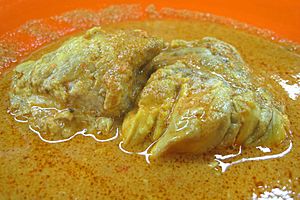Brain as food facts for kids
The brain, like many other internal organs, can be eaten as food. This is often called offal. People eat brains from animals like pigs, squirrels, rabbits, horses, cattle, chickens, camels, fish, lamb, and goats. In many cultures around the world, different types of animal brains are seen as a special and tasty dish.

Gulai otak, a cattle brain curry from Indonesia
Brains in Different Cultures
Many countries enjoy animal brains in their cooking.
- In French cuisine, you might find dishes like cervelle de veau (calf's brain) or tête de veau (calf's head).
- A dish called maghaz is very popular in Pakistan, Bangladesh, and parts of India.
- In Turkish cuisine, brain can be fried, baked, or served in a salad.
- In Chinese cuisine, especially in Chongqing or Sichuan, brain is a special treat. It's often cooked in spicy hot pot or grilled. In southern China, pig brain is used in a soup called tianma zhunao tang.
- In South India, goat brain curry or fry is a delicious meal. In Mumbai, a local community makes their own version of brain masala curry.
- In Mexican cuisine, you can find tacos de sesos (brain tacos).
- Indonesian cuisine, particularly from the Minangkabau people, has a dish called gulai banak (beef brain curry) which is beef brain cooked in coconut milk.
- In the Philippines, tuslob buwa is a popular street food in Cebu City, made from fried pig brain.
- In Cuban cuisine, "brain fritters" are made by coating pieces of brain with bread crumbs and then frying them.
- In the Ohio River Valley in the United States, especially near Evansville, Indiana, fried brain sandwiches are a popular local food.
What's Inside Brains?
Animal brains contain important nutrients.
- DHA: This is a type of omega-3 fatty acid that is very important for your body, especially for brain health. It's found in high amounts in mammal brains. For example, about 85 grams (3 ounces) of cooked beef brain has 727 milligrams of DHA. To compare, young children need at least 150 mg of DHA per day, and pregnant women need at least 300 mg.
- Fats: About 12% of the brain is made of fats, mostly in something called myelin, which helps nerve cells work. The exact types of fats can depend on what the animal ate.
- Cholesterol: Brains are also very high in cholesterol. For instance, a single 140-gram (5-ounce) serving of "pork brains in milk gravy" can have 3500 mg of cholesterol.
Important Health Information
It's important to know that eating animal brains can sometimes be linked to certain health risks if not handled properly.
- Prion Diseases: Some diseases, called prion diseases, can be spread through eating certain animal parts. One example is Variant Creutzfeldt–Jakob disease, which has been linked to eating beef brain in the past. Because of this, many countries have strict rules about which parts of cattle can be sold for people to eat.
- Another prion disease called kuru was found in a group of people in Papua New Guinea. This disease showed how important it is to be careful about what we eat and how it's prepared.
See also
 In Spanish: Sesos para niños
In Spanish: Sesos para niños

All content from Kiddle encyclopedia articles (including the article images and facts) can be freely used under Attribution-ShareAlike license, unless stated otherwise. Cite this article:
Brain as food Facts for Kids. Kiddle Encyclopedia.

